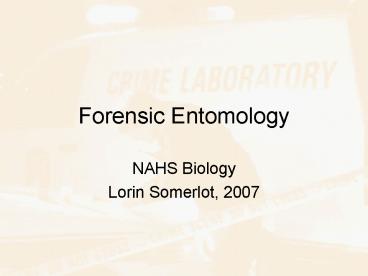Forensic Entomology PowerPoint PPT Presentation
1 / 30
Title: Forensic Entomology
1
Forensic Entomology
- NAHS Biology
- Lorin Somerlot, 2007
2
What is a Forensic Entomologist?
- A scientists who uses insects to help solve
crime.
3
How do insects help solve crimes?
- A dead body attracts insects
- Insects lay eggs on the body.
- Hatching larva use body as food.
- Larva grow at a predictable rate.
- The Postmortum Interval (PMI-how long the body
has been dead) can be determined by measuring and
identifying the developing larva.
4
Insect Succession
- Can be used to determine PMI
- Different species of insects prefer different
stages of decomposition
I prefer my corpse dried
The fresher the better!
Juicy and smelly suits me just fine!
5
Stages of Decomposition
- Living
- Initial decay
- Putrefaction
- Black putrefaction
- Butyric fermentation
- Dry decay
- http//www.deathonline.net/decomposition/movies/qu
icktime/timelapse.mov - time-lapse of
decomposition
6
Initial Decay--Day 1-3
- Bacteria, present in the intestine to digest
food, begin to eat away at the intestine itself. - Intestine decays releasing bacteria and digestive
enzymes into body cavity. - Blow flies and house flies immediately begin to
lay eggs on the defenseless body.
7
Putrefaction--Day 4-8
- Bacteria continue to break down body producing
large amounts of gasses. - Gasses inflate the body like a balloon.
- Larval flies move throughout the body, eating the
partially digested flesh. - Smell attracts other species flies and beetles.
- Rate of decay increases.
8
Black Putrefaction 10-20 days after death
- Bloated body collapses and flattens.
- Large amounts of fluids are released.
- Flesh is creamy and black where exposed.
- Several generations of flies are present.
- Wasps parasitize maggots.
9
Butyric Fermentation 20-50 days after death
- Remaining flesh is decomposed and corpse begins
to dry out. - Cheesy smell attracts new organisms.
- Body ferments and is covered with mold.
- Hardening of body makes it difficult for maggots
to feed. - Chewing beetles and their larva move in.
10
Dry Decay 50-365 days after death
- Body is dry and decays slowly.
- Hair and bones are all that remain.
- Hair is fed on my moths and bacteria.
- Mites may be present and feed on bacteria.
11
Insect Succession
12
Factors that affect decay rate and growth rate of
flies
- Temperature--the warmer the climate, the faster
the decay. - Season--early spring will decay slower, because
the insect population is still relatively low. - Degree of corpse enclosure--the more exposed, the
faster the decay.
13
Classification of a House Fly
- Kingdom - Animal
- Phylum - Arthropods
- Class - Insects
- Order - Diptera (All Flies)
- Family - Muscidae
- Genus - Musca
- Species - domestica
Musca domestica
14
Life Cycle of a Fly
- Flies lay 100-150 eggs at a time.
- Eggs hatch-1st instar
- Larva molt-2nd instar
- Larva molt again-3rd instar
- Pupa -- cocoon
- Adult fly
15
(No Transcript)
16
Another Look
17
One more time!
18
Egg Stage
- Most flies lay 100-150 eggs at a time.
- The eggs are small and oblong.
- They are white or cream colored.
- It takes 8-14 hours for the eggs to hatch after
they have been laid. - Flies only lay eggs in daylight.
19
Another look at eggs
20
Larva
- Molt (shed their skin) twice after hatching.
- Breath through anterior and posterior slits
called spiracles
21
Instar Maturation of Larva
- 1st instar larva take 8-14 more hours until they
are ready to molt. - 2nd instar larva take 2-3 days to molt.
- 3rd instar larva take 7-8 days until pupal
maturation.
Pre-pupal 3rd instar larva.
22
Spiracles are distinct
- Different species of fly larva have different
spiracle characteristics
Peritreme
Spiracular Slits
23
Pupa
- Once larva mature they stop eating and
metamorphose into an adult fly.
24
Basic Anatomy of an Adult Fly
- Insects have three body parts
- Head
- Thorax
- Abdomen
- Six Legs
- Wings
25
Identifying Adult Flies
26
Identifying Adult Flies
27
Identifying Adult Flies
28
Identifying Adult Flies
29
Identifying Maggots by Spiracular Slits
- Maggots can be identified by their distinguishing
spiracular slits.
30
Spiracular Slits

